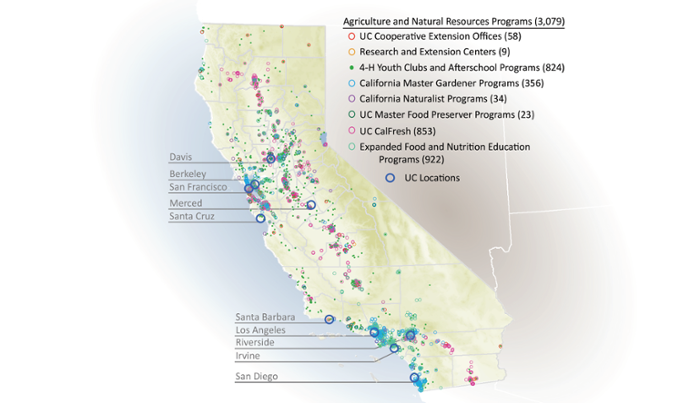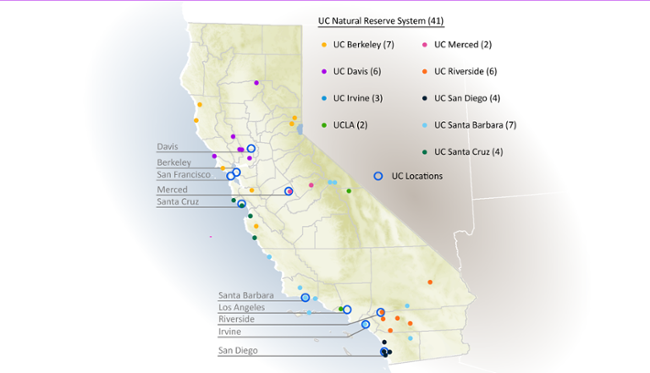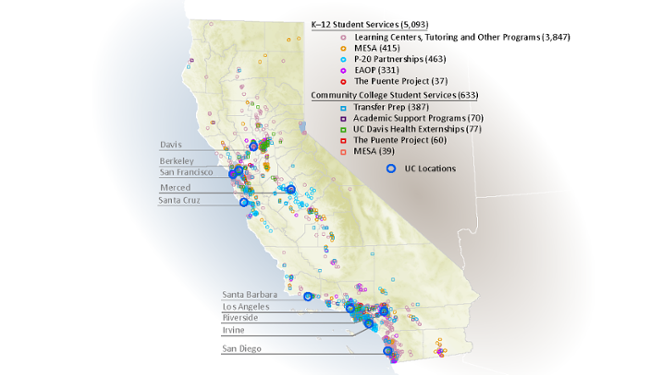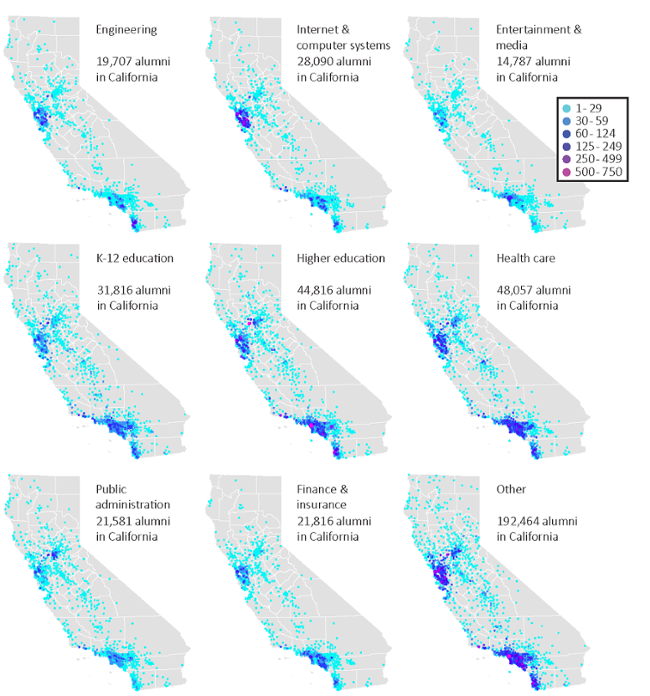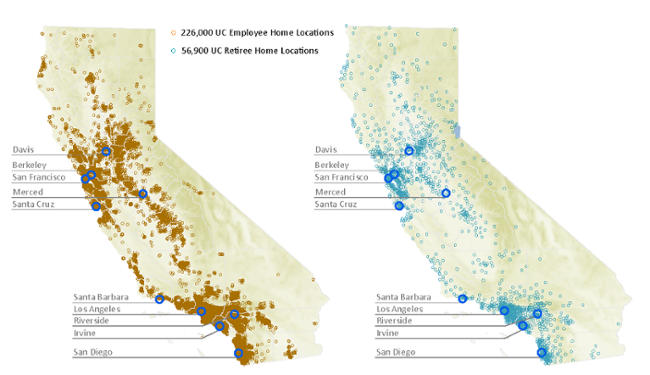chapter spotlight
Isaí Ambrosio, the program director of the Davenport Resource Service Center (DRSC) has been named the inaugural activist-in-residence of UCSC's Research Center for the Americas (RCA).
"For me, activism is about being proactive," said Ambrosio. "Here in Davenport, we have to be proactive. We have to go out and talk to people."
The residency is the brainchild of RCA Director Sylvanna Falcón, an associate professor of Latin American and Latino studies, who envisions it as a way to forge stronger ties between the university and the community.
"We were looking for people with demonstrated leadership in nonprofit and community-serving organizations, and Isaí really stood out to the selection committee," she said. "He has made a deep personal and professional commitment to social change and social justice in North County. He will be a great partner and looks forward to meeting with students, faculty, and staff."
part of the UC mission
Along with teaching and research, UC contributes to the well-being of the state’s population and economic growth through its public service efforts. UC’s impact goes well beyond its on-campus activities. UC has a significant presence in nearly every community throughout California.
Educational outreach forms a crucial part of UC’s service to the state, including a network of world-class museums, libraries, herbaria, and other facilities open to the public for shared learning. Every UC campus administers hundreds or thousands of community-based programs across a range of foci, from community and social services to teacher professional development and K–12 student services.
The University exhibits a steadfast commitment to public service in part through support of sustainable agriculture, environmental stewardship, healthy families, and education. The Division of Agriculture and Natural Resources (ANR), the UC Natural Reserve System, the community-based programs of the Division of Diversity and Engagement, and all ten campuses are highlighted in this chapter.
UC Agriculture and Natural Resources
UC’s land-grant history
The Morrill Land-Grant Acts emphasized that the role of the University is to develop “useful and practical information … and to promote scientific investigations and experiments.” The Acts created a federal-state partnership for agricultural research and technology transfer. The University of California was chartered as California’s land-grant university. Subsequently, the Hatch Act of 1887 established state agricultural experiment stations. In 1914, the Smith-Lever Act established Cooperative Extension (CE) services to extend university research through outreach and education. UC’s Division of Agriculture and Natural Resources is UC’s land-grant arm. State legislation incorporated county governments to become the third legal partner, such that today, UC ANR represents a three-way partnership with federal, state, and county governments.
UC ANR personnel and programs deliver resources from the UC system to Californians — even if there is no campus nearby. UC ANR forms teams, across UC and beyond, to develop innovative, multidisciplinary, science-based solutions to complex issues. CE is also the education and outreach arm, serving all 58 California counties by bringing UC research to local communities. UC ANR’s mission is to engage UC with the people of California to achieve innovation in research and education that supports:
• sustainable, safe, and nutritious food production and delivery
• economic success in a global economy
• a sustainable, healthy, and productive environment
• science literacy and youth development programs
UC ANR Statewide Network
UC ANR operates a statewide network of researchers and educators dedicated to the development and application of knowledge to address local agricultural, environmental, and health issues. This network of local Cooperative Extension (CE) sites and Research and Extension Centers (RECs) is often the face of the University to Californians to those with no other connection to the University. In 2018, 175 Cooperative Extension Advisors were conducting research, outreach, and education from local CE offices. Nine statewide RECs provide education for the public and places for researchers to conduct field experiments. Approximately 565 affiliated Agricultural Experiment Station (AES) researchers are located at three campuses, and 115 CE Specialists are located at five campuses, RECs, and county offices. UC ANR maintains and enhances connections that engage UC with the people of California through more than 3,000 local partnership programs (10.1.1).
In 2018, AES and CE published over 1,700 peer-reviewed publications and 340 popular articles, and developed 18 patents. CE programs, including volunteers, had close to 770,000 educational exchanges with adults and youth statewide. CE educators and volunteers disseminated science-based information through over 45,000 community-based short courses, classes, workshops, demonstrations, and field days across the state.
CE academics conducted over 680 media programs and interviews. For example, CE provided objective information on biotechnology for the documentary film Food Evolution. There have been more than 740 screenings at venues around the world to a variety of audiences, including the National Academies of Science and the Food and Agricultural Organization of the United Nations. The film has garnered critical acclaim from the New York Times, Los Angeles Times, and Forbes.
UC ANR also provided science-based information to policy and decision makers through 685 policy engagement activities. For example, academic expertise about the current status and considerations for testing lead in drinking water informed the passage of California legislation (AB 2370), which will require lead testing in childcare facilities and allocate state budget funds for implementation and remediation of any lead contamination.
UC ANR’s statewide California Naturalist Program promotes stewardship of the state’s natural resources through education and service. The program develops the curriculum, trains partner organizations, and ensures quality through monitoring and evaluation. Since its inception in 2012, the program has worked with over 45 partner organizations and certified over 2,700 graduates as California Naturalists, who volunteer in support of conservation and restoration efforts on over 700,000 acres.
UC ANR’s UC Master Gardener Program extends to the public research-based information about food gardening and sustainable landscaping, including green waste reduction, pest management, water conservation, and pollinator-friendly gardens. There are over 6,000 UC Master Gardener volunteers in 50 California counties. In 2018, they donated over 530,000 public service hours with an estimated value of $15.6 million. Participants reported adopting and improving gardening practices that protect natural resources and promote healthy people and communities. For example, they improved over two million square feet of pollinator gardens and habitat, which increases yields in home food gardens and supports local agricultural productivity.
UC ANR’s statewide 4-H Youth Development Program uses a positive youth development framework and promotes experiential, inquiry-based science learning. UC 4-H annually engages over 140,000 youth aged 5–19 to help them reach their full potential through working and learning in partnership with over 14,000 caring adult volunteers. Over the past three years, overall enrollment has increased 77 percent and enrollment of Latino(a) participants has increased 161 percent. 4-H youth report many benefits, including 88 percent who have developed science skills and abilities, and 83 percent who have participated in a community service project. The California Juntos 4-H Program bridges the gap between high school and higher education for Latino(a) youth. At the end of a three-day Academy focused on science, technology, engineering, and mathematics (STEM) education and careers, 95 percent of the Latino(a) participants indicated they are planning to attend college, compared to 45 percent on the first day. The 4-H program had the largest growth in STEM projects, with almost 170,000 youth projects on robotics, rocketry, environmental science, agri-science, biotechnology, and computer science. The 4-H STEM programs instill curiosity, critical thinking, and scientific literacy — skills needed in tomorrow’s science leaders and workforce. Seventy-two percent of the 4-H youth in grades 8–12 want a job that involves science.
UC ANR manages two statewide nutrition education programs: the California Expanded Food and Nutrition Program (EFNEP) in 24 counties and the UC CalFresh Program in 31 counties. EFNEP delivers research-based nutrition education to limited-resource families with young children to improve healthy lifestyle choices. In 2018, EFNEP reached over 51,000 adults and youth. Evaluations of adult participants indicate 95 percent improved at least one diet quality practice, and 83 percent improved one or more food safety skills. The UC CalFresh Program involves the USDA, California Department of Social Services, and UC Cooperative Extension. The program serves persons eligible for the federal Supplemental Nutrition Assistance Program (SNAP-Ed). In 2018, in-person education was provided to 110,000 participants. Evaluation findings showed individuals’ gains in healthy eating behaviors, and organizations reported policy, system, or environmental improvements, such as in school lunchrooms, farm-to-school programs, and school gardens.
The scope of UC ANR impact
California is a national and global leader in food production and agricultural exports, which are affected by social, regulatory, economic, and environmental challenges. Despite the state’s robust agricultural sector, one out of every eight Californians does not know where their next meal will come from. UC ANR lives and works in communities, conducting research and communicating findings through demonstrations and educational programs to improve food quality, quantity, safety, and access. As a result, growers increased yields while reducing inputs, improving efficiency and profitability, and contributing to the state’s economic prosperity. In addition, UC ANR participants demonstrated learning and behavior changes related to food resource management and informed food polices, which can lead to increased access to affordable, safe, and healthy food.
The state’s natural resources face threats from climate change, urban sprawl, air and water pollution, and invasive species. Rangelands and forests are experiencing the effects of wildfires and droughts. UC ANR translates research into actionable management strategies to protect the environment and increase the long-term viability of farming, ranching, and forestry in California, and to help communities deal with growing risks from fires and droughts. As a result of UC ANR outreach and education, landowners adopted recommended practices for grazing and rangeland management, water conservation and preserving water quality, and sustainable use of forest and wildland resources. In response to the state’s past two years of catastrophic wildfires, UC ANR conducted fire hazard research, some of which was incorporated into CAL FIRE’s protocol. Outreach and education on fire resiliency has been used in community planning and policies. In this way, program outcomes contribute to increased ecological sustainability and help California realize the many benefits of the state’s rich and diverse natural resources.
California’s rapid population growth increases pressure on community resources, presenting challenges to health and safety. UC ANR produces tools, programs, and policy-relevant research that result in healthy living for individuals and communities. Program participants adopted healthy lifestyle practices and communities gained improved access to green spaces and healthy foods. In addition, UC ANR childcare research findings informed nutrition policy at both federal and state levels, and resulted in revisions to the federal Child and Adult Care Food Program nutrition standards. Benefits also include safe drinking water, clean air, and reduced exposure to pesticides. Collectively, these efforts contribute to a healthier California, improving public health and reducing healthcare costs.
UC Natural reserve system
The UC Natural Reserve System (NRS) is a network of protected natural areas throughout California. These lands are managed for research, teaching, and public service, and are a major component of UC’s environmental stewardship. Its 41 reserves, covering more than 756,000 acres, make it the largest university-administered reserve system in the world (10.2.1).
As one of four trustee agencies recognized under the California Environmental Quality Act, the University of California holds reserve natural resources in trust for the people of the State of California. Reserve managers protect endangered plants and animals, restore native habitats, and control invasive species. Reserves also serve the public by holding lecture series, guided hikes, and other community events; lending scientific expertise to conservation initiatives; and hosting tens of thousands of California schoolchildren on field trips.
Most major state ecosystems are represented in the NRS, from coastal tidepools to inland deserts, oak savannas to offshore islands, and wetlands to Sierra Nevada forests. Reserves also serve as gateways to more than one million acres of public lands. NRS reserves include lands purchased by the University, donated by private landowners, and made available to the reserve system via partnerships with state and national parks, land trusts, and government agencies. Reserve amenities such as classrooms, lodging, laboratories, and internet access attract tens of thousands of users each year. These include researchers, students taking university courses, schoolchildren, and the general public. Those who seek to understand the workings of natural California come to the NRS to take classes, develop field skills, and conduct research.
More than 150 undergraduate courses across the UC system include visits to NRS reserves each year. Topics of study range from botany to zoology, archaeology to environmental planning, public health to the performing and visual arts. Scientists flock to reserves because reserve lands are protected in perpetuity. They feel comfortable launching long-term studies within reserve boundaries. Work at reserves produced more than 2,900 peer-reviewed papers, book chapters, and books between 2010 and 2018.
In 2019, Point Reyes Field Station and Lassen Field Station joined the NRS as partnership reserves, which are jointly managed with the National Park Service at Point Reyes National Seashore and Lassen Volcanic National Park, respectively.
More than fifty years after its inception, the need for the NRS has never been greater. Climate change, pollution, extinctions, and invasive species are fraying the fabric upon which life on Earth depends. By supporting university-level teaching, research and public service, the NRS contributes to the understanding and wise stewardship of the Earth.
EDUCATIONAL PARTNERSHIPS
For nearly 50 years, the University of California’s Student Academic Preparation and Educational Partnerships (SAPEP) programs have helped prepare California students for higher education (10.3.1). Program activities are centered on student academic preparation, community college articulation support, school and community partnerships, and online and technology-assisted services. SAPEP programs served nearly 180,000 K–12 students at more than 1,400 public schools and more than 27,000 students at all 114 California community colleges in 2017–18.
The goal is to promote achievement by supporting academic preparation and college readiness. Programs include the Early Academic Outreach Program (EAOP), which focuses on “a–g” course completion (a prerequisite for admission to UC and CSU); K–20 Regional Intersegmental Alliances (aka P–20), creating ties between campuses, schools, local communities, and business organizations; The Puente Project, focusing on college-preparatory English skill development; Transfer Prep, focusing on community college transfer support; and Mathematics, Engineering, Science Achievement (MESA), focusing on STEM (science, technology, engineering, and mathematics) skills development.

The Mathematics, Engineering, Science Achievement (MESA) program integrates UC’s core missions of teaching and public service by focusing on the academic preparation of students at K–12 schools, community colleges and four-year universities. Through its three components — the MESA Schools Program (MSP), the MESA Community College Program (MCCP), and the MESA Engineering Program (MEP) — MESA serves more than 25,000 California students annually.
MESA Schools Program (MSP) centers are housed in 18 locations and serve more than 18,000 students at about 400 K–12 schools. Centers offer classes that reinforce math and science content standards. MESA activities include workshops aimed at strengthening study skills and monitoring progress.
The MESA Community College Program (MCCP) manages 36 centers at community colleges, serving around 4,000 students annually. These centers provide academic excellence workshops, orientation courses, academic advising, and counseling activities to help community college students transfer to a four-year university in a timely manner.
The MESA Engineering Program (MEP) operates 13 centers located in public (UC and CSU) and private universities across the state. Serving about 3,000 students annually, these centers assist college students in attaining four-year degrees in engineering and computer science by providing tutoring and academic skills workshops. In partnership with local industry leaders, MEP centers also provide career and professional development opportunities for students. In addition to the activities UC undertakes to strengthen K–12 and community college students academically, UC plays an important role in preparing California’s teacher workforce. UC’s Teacher Education Programs prepare teacher candidates to engage students in rigorous, relevant, and inquiry-based educational experiences. Located at eight UC campuses, Teacher Education Programs recruit, prepare, and support educators who are committed to academic excellence, equity, and integrity, and to cultivating the highest levels of achievement and opportunity for all students.
UC also provides ongoing support to educators already in the workforce through professional development programs. For example, the California Subject Matter Project (CSMP) is a network of nine discipline-based statewide projects, providing more than 2,000 professional development events for educators at more than 10,000 schools each year. CSMP professional learning opportunities are aligned with state-adopted standards and are collaboratively designed by K–12 and university educators to enhance learning for all students (10.3.2).
Social and economic impacT
Including the programs of ANR, the Natural Reserve System, and UC’s educational partnerships mentioned above, the University of California administers more than 20,000 community-based programs across the state. Because the well-being of every California citizen and community is important, all campuses sponsor and manage programs far from their locations. For example, UC San Diego, near the southern border of California, runs clinical internship sites in Crescent City and other communities near the northern border of California; UC Davis, in the Central Valley, runs the Oiled Wildlife Care Network in Morro Beach on the central coast; and UC Santa Barbara, on the California Coast runs the Outdoor Science Education Program in several locations on the east side of the Sierra Nevada range. All of UC’s community-based programs may be discovered and explored here.
UC’s social impact
Through community and social services programs and cultural resources and arts programs, UC administers internship and field study programs that connect students and alumni with their communities; volunteer centers working on issues such as domestic violence, fair housing advocacy, and employment training; arts education and outreach programs that teach art, dance, drama, music, and digital arts in the community (10.4.1).UC’s economic impact
Through business and economic development programs and public policy programs, UC facilitates internships offered in partnership with local companies, where students gain both UC credits and professional experience. Other programs bring local high-tech and green-tech companies together with motivated individuals to foster student participation in community economic development (10.4.1).
As California’s economy becomes increasingly dependent on highly educated workers, the role of the University of California in training the state’s future workforce becomes more vital. Industries relying on skilled workers in the STEM fields represent a major component of California’s economy. UC awards half of the state’s bachelor’s degrees in STEM fields.
More than 1.2 million UC alumni live and work in California (10.4.2). They are leaders, volunteers, and contributors to the vitality of its communities, businesses, and culture. UC’s operations also add significantly to the state’s economy. With approximately 210,000 employees, UC is California’s third-largest employer (10.4.3). With expenditures of about $29.5 billion, much in the form of salaries, wages, and benefits, UC annually generates more than $46 billion in economic activity in California. UC contributes more than $32 billion to the gross state product and attracts over $8 billion in annual funding from outside the state. True to its land-grant mission, the UC system touches many aspects of life in California. The UC public service mission has evolved in tandem with the changing needs of our state and local communities, and has developed programs and partnerships that improve the lives of all Californians.
For more information
